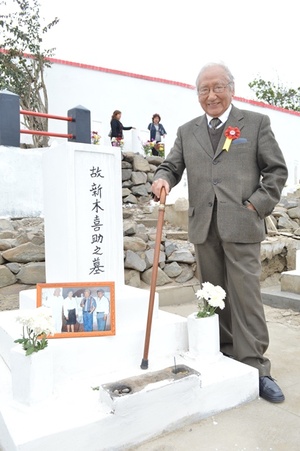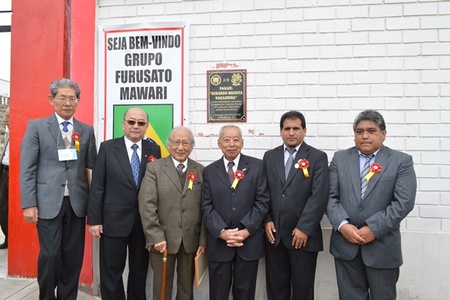Gerardo Miguita and Venancio Shinki have a lot in common. They are more than prominent or successful Nikkei. It is as if the distant tranquility, the cordial smile and the invisible wisdom of things and moments were part of each person's skin. They are the living history of the Japanese migrants and their descendants who settled in the Hacienda San Nicolás* and the surrounding towns of the province of Barranca, north of Lima.
The best-known Nisei of Supe Puerto and the prestigious national painter were honored on Sunday, September 28, by the Nikkei community and the authorities of the Supe district at the historic Japanese Cemetery of Saint Nicholas.

WATCHING OVER THOSE WHO REST IN SAN NICOLÁS

Don Gerardo is recognized for his selfless dedication and his constant concern for taking care of this cemetery where the remains of the Japanese pioneers lie. For the last 35 years he has been in charge of maintaining the place, even using his own money to do so. For this reason, the municipality of Supe agreed that the access street to the place where 480 graves of bodies and the ashes of unidentified remains rest will now bear the name of Gerardo Miguita Nakashima. "This is not what I expected. This recognition in life fills me with great satisfaction,” he expresses with a warm voice and at more than 80 years old.
He is standing next to the plaque that bears his name. Everyone takes photos of him. Deeply moved, but with the serenity that now governs him, Don Gerardo listens to the brief speeches of those who pay tribute to him and highlight his honorability and vocation of service towards the Nikkei community and the people of Barranca.
Don Gerardo feels calm. The tribute closes a period of his concern for the preservation of the cemetery. Now the Peruvian-Japanese Association of Barranca will be in charge of taking care of the beautiful cemetery. “My interest has always been that this place has a legal status, and now, in addition, the municipality of Supe has declared it historical heritage, and in turn has begun the process to have it recognized by the Ministry of Culture as well. I feel enormous satisfaction and I can say that when one leaves, there will be someone who will watch over those who rest in San Nicolás,” he expresses.
Surely Don Gerardo will now have more peace of mind and more time to observe the sea from Supe Puerto, where he lives. There is their Miguita winery, next to the municipality and it is a must-visit point. And perhaps you'll even catch a sole or a bass, as you did before, to prolong your life with a plate of sashimi and another of ceviche. However, you will never stop visiting the beautiful Japanese cemetery where the pioneers and their descendants rest, and perhaps without realizing it you will fulfill the phrase that is read in the mausoleum: “Never forget the grave of your ancestors.”
IT ALL STARTED AT SIX YEARS OLD
Don Venancio Shinki Huamán speaks slowly, remembers, the images of his childhood at the Japanese School of the Hacienda San Nicolás appear in his mind: “There was a large Japanese colony. And the cutest thing was the undokai at school. You have no idea what it was. The gakkoo was huge and well organized. It was barbaric! I was a child and I was amazed. School was the most beautiful experience I had, but on the other hand it was also the most painful. However, later everything is fixed.”
Don Venancio says that the other Japanese children who were starting their first year of school with him, and who came from Supe, the other haciendas in Barranca or who lived in the countryside, did not include him in their games and entertainment. That happened “because mom was Peruvian.”
“At recess I stayed watching how the other children were having fun. But God is great. There is nothing to do because God is great. I was six years old and it was the first days at gakkoo, and packages arrived from Japan with supplies for each child. After bowing, the sensei gave his supplies to each student. What a beautiful time!” he remembers.
He continues: “Among the books and notebooks I found one that was about arts and crafts, and had chapters for making origami, for drawing and painting, for making collage. So I grabbed that book and adopted it, and from that moment on that book was the one that saved me from marginalization and harsh treatment from some classmates. That book saved me. I dedicated myself to drawing, painting and making origami with my book. That's why I say that thank God everything works out: that book gave a six-year-old child something to do. That was the beginning, and now I am surprised by how life works: at the age of six I began to make my profession.”
Now, after so many years and having become a reference in national art, life continues to get better. Shinki was declared favorite son by the municipality of Supe and by the Peruvian Japanese Association of Barranca. “This recognition is an honor for me. It is a particular emotion, so much so that in the simple ceremony that took place – and everyone present knows it – I got emotional, my voice stopped. God, I made a mistake! I am very sensitive, that is my way of being; I am a crybaby, well, like many Nisei who are crybabies…” Don Venancio laughs and his eyes shine again.
* The colony of Japanese migrants that arrived at Hacienda San Nicolás between 1899 and 1909 numbered nearly three thousand people. They worked in sugar cane plantations.
* This article is published thanks to the agreement between the Peruvian Japanese Association (APJ) and the Discover Nikkei Project. Article originally published in Kaikan magazine No. 92, and adapted for Discover Nikkei.
© 2014 Texto: Asociación Peruano Japonesa; © 2014 Fotos: Asociación Peruano Japonesa / Jorge Fernández








